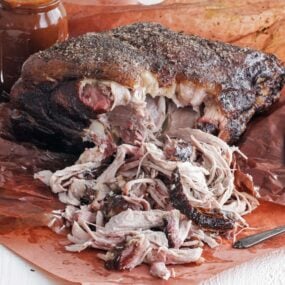

Smoked Pork Butt Recipe
This Smoked pork butt recipe is seasoned and slow-cooked in apple wood, making tender, flavorful meat that you won’t be able to stop eating.
Ingredients
- 10 to 12 pound bone-in Pork Boston Butt
- ¼ cup yellow mustard
- 2 tablespoons coarse salt, you may need an additional tablespooon
- 1 tablespoon ground black pepper
Instructions
- Preheat the smoker to 250°. Start by coating the pork butt on all sides with the mustard.
- Next, generously season it on all sides with salt and pepper. It’s important that all 6 sides of the butt are seasoned for maximum flavor.
- Place the seasoned pork butt on the grates and place a thermometer in the center of it. I like to place it on a top grate with a pan below to catch any drippings to avoid any “grease” smoking. Smoke until the butt stalls, which is usually between 160° and 165°.
- If you notice any spots drying out on the top or sides of the pork, feel free to spray some BBQ spritzer on it. This will help add flavor, tenderize it, and stop that area from crisping up too much.
- Remove the pork and place in two sheets over overlapped butcher’s paper that is roughly 3 feet long. Fold the bottom part of the paper up to wrap around the pork. Next, fold the paper right over left. Then fold it left over right. Roll the butt forward making sure it is still fat cap side up and the paper is underneath.
- Place it back on the smoker in the same spot and pierce again in the center with a thermometer.
- Smoke the pork until it reaches at least 202° or more. Pork will technically shred starting at 190°, but I find it to be juicier and more tender when pushed to 202° plus.
- Remove it and let it rest at room temperature for 30 to 45 minutes. You can let it rest for even longer. If you do decide to do that keep it well insulated like in a cooler to help keep temperatures above the 140° danger zone.
- Pull or shred the pork using your hands or two large forks.
- Serve it with my famous BBQ sauce for Pulled Pork Recipe.
Notes
Make-Ahead: You can make this up to 8 hours ahead. If you do this, keep it covered and in the oven or warmer at low temperatures (<180°).
How to Store: Cover and keep it in the fridge for up to 5 days. Freeze it covered for up to 6 months. Thaw it in the refrigerator for one day before reheating.
How to Reheat: Add the desired amount of smoked pork butt to a baking dish or pot with a lid, along with 1 cup of chicken stock or water, cover, and bake in the oven at 300° for 25 to 30 minutes or until warm.
I used a pellet smoker for this recipe. To create this recipe, use a regular charcoal grill, offset smoker, smoker pit, or digital smoker.
While I wrapped the pork in peach or butcher’s paper, you can also use aluminum foil. The butcher's paper is porous enough to let smoke in while keeping the bark intact. Rendered pork fat and juices will not cause holes in the paper as it smokes.
You can brine the meat or inject it with vinegar, juices, and seasonings.
Try using pork lard instead of the mustard, a binder for the salt and pepper.
You can dry brine the pork by coating it in salt and pepper, without the mustard, and leaving it on a rack over a tray in the refrigerator uncovered for 8 to 48 hours before smoking.
Pellet smokers tend to produce on the lighter side of smoke infused into the food. Because of that, I do not pull the pork butt out of the fridge too early before smoking so that the extra time in the smoker can be used to get smokier flavors.
My favorite woods for this are alder, cherry, apple, oak, pecan, and hickory.
Temperatures for smoking a pork butt can vary from 200° to 275°.
The stall refers to a period during which the pork stands still at the same temperature for longer than usual. Sometimes, it can go quickly, and sometimes, it can take hours, so we wrap it to help move it along.
Maillard reaction, also known as the browning reaction, is an interaction between sugar and amino acids in the steak when heated to 285°and 350° over high heat, browning the meat to enhance the flavor and add more crispness. This is not the same as caramelizing.
Nutrition
Calories: 452kcalCarbohydrates: 0.4gProtein: 64gFat: 20gSaturated Fat: 7gPolyunsaturated Fat: 2gMonounsaturated Fat: 9gTrans Fat: 0.1gCholesterol: 204mgSodium: 1136mgPotassium: 1164mgFiber: 0.3gSugar: 0.1gVitamin A: 5IUVitamin C: 0.02mgCalcium: 52mgIron: 4mg